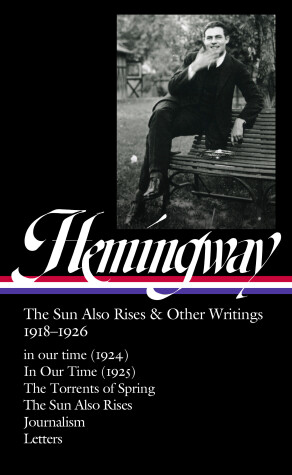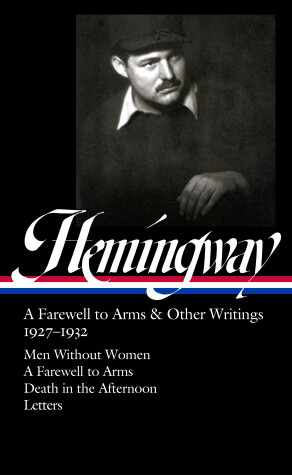Loa
2 primary works
Book 334
Ernest Hemingway: The Sun Also Rises & Other Writings 1918-1926
by Ernest Hemingway
Published 22 September 2020
Library of America launches its long-awaited Hemingway edition with a landmark collection of writings from his breakthrough years, in newly edited, authoritative texts.
With a letter of introduction from Sherwood Anderson, Ernest Hemingway travelled to Paris in 1921. There, he ame into contact with Gertrude Stein, F. Scott Fitzgerald, Pablo Picasso, James Joyce, and other expatriate writers and artists integral to his rapid development as a writer. This volume brings together work from the extraordinary period of 1918 to 1926, in which Hemingway's famous prose style became fully formed. It includes his work for the Toronto Star and Hearst's International News Service, the indelible stories of In Our Time (1925), The Torrents of Spring (1925), and his masterpiece, The Sun Also Rises (1926).
Edited by Hemingway scholar Robert W. Trogdon, this volume features newly edited, corrected texts of In Our Time, The Torrents of Spring and The Sun Also Rises, fixing errors and restoring Hemingway’s original punctuation. It presents the 1924 edition of in our time issued by Three Mountains Press as a modernist masterpiece in its own right, apart from the subsequent versions published by Boni & Liveright and Scribners. It includes the story “Up in Michigan,” one of only a few stories dating from the period before 1923 that was not lost in Hemingway’s suitcase in the Gare de Lyon and that was originally intended as the opening story of In Our Time, and the hard-to-find, previously uncollected story “A Divine Gesture.” Also here are a selection of Hemingway’s letters from the period, which cast light on his breakthrough years and at the extraordinary international modernist moment of which he was a crucial part.
With a letter of introduction from Sherwood Anderson, Ernest Hemingway travelled to Paris in 1921. There, he ame into contact with Gertrude Stein, F. Scott Fitzgerald, Pablo Picasso, James Joyce, and other expatriate writers and artists integral to his rapid development as a writer. This volume brings together work from the extraordinary period of 1918 to 1926, in which Hemingway's famous prose style became fully formed. It includes his work for the Toronto Star and Hearst's International News Service, the indelible stories of In Our Time (1925), The Torrents of Spring (1925), and his masterpiece, The Sun Also Rises (1926).
Edited by Hemingway scholar Robert W. Trogdon, this volume features newly edited, corrected texts of In Our Time, The Torrents of Spring and The Sun Also Rises, fixing errors and restoring Hemingway’s original punctuation. It presents the 1924 edition of in our time issued by Three Mountains Press as a modernist masterpiece in its own right, apart from the subsequent versions published by Boni & Liveright and Scribners. It includes the story “Up in Michigan,” one of only a few stories dating from the period before 1923 that was not lost in Hemingway’s suitcase in the Gare de Lyon and that was originally intended as the opening story of In Our Time, and the hard-to-find, previously uncollected story “A Divine Gesture.” Also here are a selection of Hemingway’s letters from the period, which cast light on his breakthrough years and at the extraordinary international modernist moment of which he was a crucial part.
Book 384
Ernest Hemingway: A Farewell to Arms & Other Writings 1927-1932
by Ernest Hemingway
Published 1 October 2024
The Library of America's definitive Hemingway edition continues with three classic works, all presented in new, corrected texts.
This much anticipated second volume in Library of America’s edition of the collected writings of Ernest Hemingway brings together 3 of the author’s classic works from the late 1920s and early 1930s, all presented in new, corrected texts prepared by Hemingway scholar Robert W. Trogdon. Reinstating expletives redacted by Hemingway’s editor Maxwell Perkins, fixing numerous errors, and restoring Hemingway’s preferred American spellings, these texts bring us closer than ever before to Hemingway’s intentions for his books. Here for the first time in one volume are:
The volume also includes a selection of Hemingway’s letters from 1927 to 1932 that cast light on his life, artistic aims, and publishing activities during this period. A detailed chronology of the author’s life, explanatory notes, and a textual essay bring added value for readers.
This much anticipated second volume in Library of America’s edition of the collected writings of Ernest Hemingway brings together 3 of the author’s classic works from the late 1920s and early 1930s, all presented in new, corrected texts prepared by Hemingway scholar Robert W. Trogdon. Reinstating expletives redacted by Hemingway’s editor Maxwell Perkins, fixing numerous errors, and restoring Hemingway’s preferred American spellings, these texts bring us closer than ever before to Hemingway’s intentions for his books. Here for the first time in one volume are:
- Men Without Women (1927), Hemingway's second short story collection, which includes such classic stories as “In Another Country,” “The Killers,” “Ten Indians,” and “Hills Like White Elephants”
- A Farewell to Arms (1929), Hemingway's heartbreaking novel of love and war
- Death in the Afternoon (1932), his grand meditation on bullfighting, mortality, and writing. For this deluxe edition, all 81 of the book’s photographs of bullfights and bullfighters have been reproduced from the original prints and postcards gathered by the author, bringing them vividly to life as never before.
The volume also includes a selection of Hemingway’s letters from 1927 to 1932 that cast light on his life, artistic aims, and publishing activities during this period. A detailed chronology of the author’s life, explanatory notes, and a textual essay bring added value for readers.

